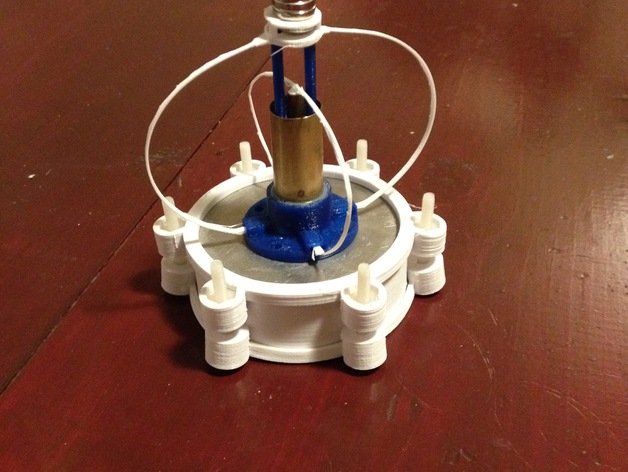
Free-piston Stirling engine
thingiverse
This is a free-piston Stirling engine that I made in 2014. I designed this engine so that minimal metal working is required. All that is needed is to cut two 3" aluminum disks, drill a central hole in one, and cut 4 pieces of tubing and glue them onto 3D printed parts. This is as close to a fully 3D printed engine as I could come up with with no (or minimal if you want to avoid large amounts of filing) machining required. The piston, cylinder, displacer gland and displacer rod are all brass tubing that you can purchase at a hobby store (sizes used are: 21/32", 5/8", 1/4", 7/32").. The rest are 3D Printed parts that I made on my newly purchased Type A Machines 3D printer (2014 Series 1). The blue parts are all PLA, and the white parts are PET+ (purchased from MadeSolid). The PET was required for the higher temperature on the hot plate (ABS might have been a better choice but it prints with lots of fumes). PLA quickly deforms from the temperatures required to get the engine to run. The springs are the limiting factor in the engine, the slightest amount of misalignment (happens while the engine runs) causes the displacer rod to rub and this throws off the timing and the engine slows or stops. I also have an attachment which holds a coil of wire, but 800 turns isn't quite enough to get it to light an LED. I have yet to check the voltage coming out of it. In the video, boiling water was put into a thermos and ice put on top of the engine. https://www.youtube.com/watch?v=Dxu6yYSwVnk Print Settings Printer Brand: Type A Machines Printer: 2014 Series 1 Rafts: No Supports: Yes Resolution: 0.2mm Infill: 20% Notes: Print the springs flat with supports. The displacer chamber and cylinder holder o-ring gaps were correct for my printer, I can change the gap if requested (sealing is created on the side walls) Many of the parts may need to be rotated to print correctly. Post-Printing Materials Needed (sorry metric system!) 2 3" disks of aluminum with a central hole in one disk (11/16"). 21/32", 5/8", 1/4", 7/32" brass tubing. 1" ID o-ring , 1/16" thick 2 3/4" ID o-ring, 1/16" thick Small pieces of foam for the regenerator slots, and styrofoam to glue to the "displacer" (1/4" thick). 6 10-32 screws (1.5") and nuts Optional: Disk magnets 1/8" thick, 1/2" wide Thin magnet wire See the attached video for running and assembly. Custom Section Building You will need to drill (or file) a centered 11/16" hole with small ears at 180degrees to each other in one aluminum plate (to hold the bottom of the cylinder holder when the top is screwed on). You will also need to glue in the piston insert, the piston cylinder, and glue on a piece of styrofoam to the "displacer.stl" holder. The springs may need to be bent slightly to get the right amount of "springyness" and the right height.
With this file you will be able to print Free-piston Stirling engine with your 3D printer. Click on the button and save the file on your computer to work, edit or customize your design. You can also find more 3D designs for printers on Free-piston Stirling engine.
